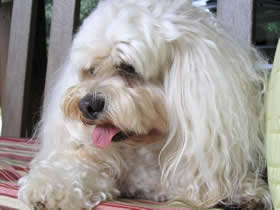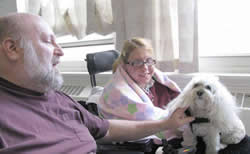The healing power of dogs
Tewksbury Hospital implements Pet Therapy to great success
By CHARITY B. LEGVOLD
Published: Saturday, April 24, 2010 8:07 AM EDT
 TEWKSBURY – Tewksbury State Hospital found a way to incorporate ‘man’s best friend’ into its patient treatment plans with great success in less than one year since the program began last summer. TEWKSBURY – Tewksbury State Hospital found a way to incorporate ‘man’s best friend’ into its patient treatment plans with great success in less than one year since the program began last summer.
In June of 2009 Recreation Therapist Katie Morley began the Pet Therapy program with the introduction of “Tucker,” a four-year old Cockapoo who visits once per week in the Brain Injury Unit. Tucker and his owner, DJ Popelka, are members of Dog B.O.N.E.S. (Dogs Building Opportunities for Nurturing and Emotional Support), a network of Massachusetts Therapy Dog volunteers.
Popelka said Tucker was born to be a therapy dog and that when Tucker went to live with Popelka at just nine-months old, he was already well socialized, calm, loving, and “working his magic.” He went to work with Popelka daily and was a natural in the caregiver, patient environment. Tucker adapted well to early mornings, non-puppy schedules, and unexpected interruptions. Noise, unusual equipment, and numerous new faces became second nature to him. In fact, the dog seemed to thrive in this uncertain environment.
Tucker, and the three dogs that are following in his footsteps at the Tewksbury State Hospital, are all registered Therapy Dogs. Jaeger, a German Shepherd began in July 2009, and two more units have gotten dogs in the first part of 2010. The goal is for all eight units to eventually have dogs that meet their specific needs.
Morley said that the beauty of the pet therapy is that the patients enjoy the dogs, so they think of it as time to be with the dogs, not as time to work on physical, occupational or emotional therapy. The throwing motion the patient has been working on in occupational therapy, for example, comes to life when that motion is for throwing a ball to play catch with a dog like Tucker.
We expected it to be successful and for patients to enjoy it,” said Morley, “but it was way more impactful than we  ever thought it would be.” ever thought it would be.”
Popelka wonders who benefits more, the patients or the therapy dog team. “Maybe it’s a draw,” said Popelka adding, “Being a therapy dog team member, it goes without saying, is one of the most personally rewarding experiences I have had as a volunteer.”
Morley acknowledges that this program would not be possible without the therapy dog volunteers as well as the doctors and nurses for their support because each patient who has contact with the dogs must have the pet therapy written into their care plan for a specific reason.
Without revealing any identities, the true patient stories that follow are examples of how the dogs are having an impact on the people they visit each week.
Patient One:
Patient one is a man who involuntarily bounces his body, especially when trying to verbally communicate or move his arms. He has difficulty forming words, but with some patience he can get some out.
Morley noted that when either of the therapy dogs visits, a smile comes across this patient’s face immediately. Recently, when the dog named Jae-Jae was visiting, the patient managed to reach his arm out and touch the back fur. Morley said the man’s body just melted into a calmed state.
He worked on forming some words that told his visitors that he had owned a dog of very similar coloring. About a half hour later Morley saw the man bouncing again as she went by his room. He had just been put to bed for the evening. When she went in and talked briefly with him about the dog’s visit and told him that a dog would be visiting each Wednesday, His body immediately "melted" again and things were calm for him if only for a short time.
Outcomes for patient one: Increased communication, decreased anxiety, tactile stimulation
Patient Two:
This female patient has multiple long-standing medical problems; one of which makes it very difficult to get out of bed and sit in her chair. On Wednesdays, when her unit has Pet Therapy, she now asks to be up and ready so that she can "walk" the dog. This consists of holding the leash and riding along side a very well trained dog, but Morley said that for her to be up and moving her power chair is quite an accomplishment.
Outcomes: Increase in physical function, increase in endurance, companionship
Patient Three:
This patient is a dog lover who is unable to see his own dog who he reports to miss very much since his admission. The patient has been working on his fine motor skills in other therapy sessions, particularly Occupational Therapy.
During Tucker’s early visits, this patient would remove and reattach the leash - each time he attempts this task he is able to do so faster and more accurately. The smile on this patient’s face demonstrates how important Tucker’s companionship is to the patient.
This patient was an athlete prior to his injury, and since the time of admission has been unable to throw a ball. During the previous two weeks, while working with his occupational therapist, this patient has been able to perform this skill with multiple verbal cues.
During Tucker’s latest visit, his owner brought in some balls from home. This patient was able to throw the ball to the dog multiple times with minimal verbal cues. The occupational and recreational therapists were very impressed with this improvement, along with the patient’s mother who was able to witness his successes.
Outcomes: improved gross motor skills, improved fine motor skills
Patient Four:
This female patient grew up with animals at home, and is a cat lover, but put Tucker in front of her and her face lights up. When this patient was transferred to the unit she isolated herself and did not attend any groups. Currently this patient attends all recreation therapy groups offered on unit, but her favorite is pet therapy.
She moves her chair around the unit looking for Tucker and waits in the hallway to try to visit with Tucker as soon as she is able. She is very aware of the day of the week now and begins looking forward to the visits on Tuesdays. Tucker sits on her lap and the patient gives him a "puppy massage" with her one hand that remains functional.
Tucker snuggles right in resting his head on the arm rest on her wheel chair. When Tucker's owner says its time to go, Tucker snuggles in a little closer, and this patient laughs out loud. Morley noted that the only times she has seen the patient laugh out loud is in the presence of Tucker. Her family is also very excited that she is able to have a visit with the therapy dog weekly and has noticed an improvement in her mood.
Outcomes: companionship, reduced anxiety, memory recall
|